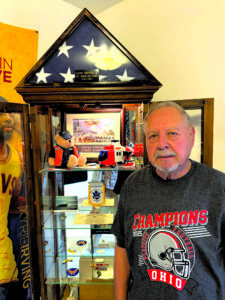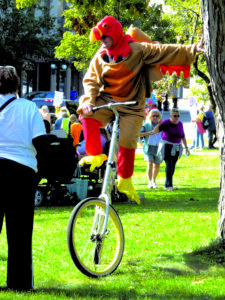Boardman Coast Guard vet recounts harrowing mission

Lloyd Griffith of Boardman stands next to memorabilia he saved from his time of service in the U.S. Coast Guard in the 1960s. The display also includes items from his father, who served in World War II. Submitted photo
After graduating from the former North Lima High School in 1962, Lloyd Griffith attended Youngstown State University.
Due to his low grades, he was placed on probation and was told he either had to get his grades up or he would be drafted into the Army and sent to Vietnam. When Lloyd witnessed his buddies being drafted, he went to the Coast Guard recruiting station in Youngstown to enlist.
After passing the entry exam, he was sent to Cape May, New Jersey, for basic training and was then sent to a buoy tender (a vessel used to maintain and replace navigational buoys) in Toledo, where he served on the USCGC Tupelo for six months.
From there, he received orders to transfer to a Coast Guard station in Miami Beach, where for two months he received training in search and rescue. He was then transferred to Puerto Rico and given the opportunity to become a radio operator at the Coast Guard lighthouse in Cape San Juan, where he remained stationed for 18 months.
In 1966, Griffith was transferred to Port Huron, Michigan, where he served on the Coast Guard cutter, Acacia. His ship received an SOS to head to the ship Nathaniel J. Morrell on Lake Huron, which was in the middle of a huge storm and fighting to stay afloat. The Acacia immediately departed for what they thought was the location of the ship. When they arrived, they discovered that the Morrell had broken in half and sunk. All that was left was debris, 29 victims and one survivor.
The Acacia was one of three Coast Guard cutters responding to the tragedy, retrieving eight bodies with the other two ships recovering the remaining 20 bodies. Griffith says it was above and beyond anything he had previously experienced on the Great Lakes.
“The weather was so bad I was hanging on for dear life,” he said. “I was at the helm trying to navigate the ship, and everyone on board was sicker than a dog.
“It wasn’t Vietnam, but I had my moments.”
Looking back on his service, Griffith is thankful for two things: “First, I am thankful that I met a tremendous number of great men and women whom I worked with; and second, I was able to serve my country in a peaceful way.”
In the Coast Guard, Griffith began as a seaman recruit and was promoted twice: seaman apprentice 1 and then to seaman first class 2. His objective was to be able to return to the U.S. and continue his education.
The most difficult part of his service was the night of recovery on Lake Huron when he had to bring bodies aboard, put them into body bags and then into the forward hold.
“It was hard identifying the sailors, there were missing body parts we didn’t find,” he said. “It was difficult.”
Griffith was discharged in 1967 and went back to the now-defunct Youngstown Business College, where he earned a degree in economics and business. He worked in the trucking field as a terminal manager for 16 years when the company went belly up. He was offered a job with United Paper Service in Youngstown and was there for seven years before that company closed. He was offered a position with the Boardman Township Road Department and at the time was 52 years old. When interviewed he was asked if he would be able to take orders from someone younger than himself.
In response he said, “I’ve been taking orders from someone younger than I am for 10 years — it’s called my wife!”
He worked there for 10 years, and because at 62 he was eligible for Social Security he retired to Boardman. His wife, Carol, died in 2007. Griffith has two sons and one daughter.
In retirement, Griffith’s favorite hobby is traveling. He joined the group DARE which stands for: death and divorce aren’t really the end. He has been going on trips for 17 years and says that his favorite trip was to Alaska.
Another hobby is collecting beach glass. In addition to collecting it, he has the larger pieces made into jewelry.
Griffith followed his father, Lloyd Griffith Sr., who served in the U.S. Army Air Corps from 1942 to 1944. His father was sent to the Philippines “but he didn’t like to talk about it as there was so much killing.”
When asked what he takes away from being in the service he answered, “I gained a lot of insight about humans, interacting with guys my age and getting our feet wet in the world.
“We were fortunate and lucky to have the option to serve the way we did. After the war, I was able to continue my education, marry, have a family and travel. Many didn’t have that option and didn’t come back.”


